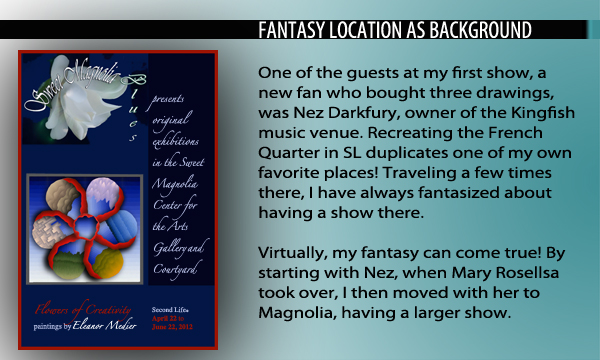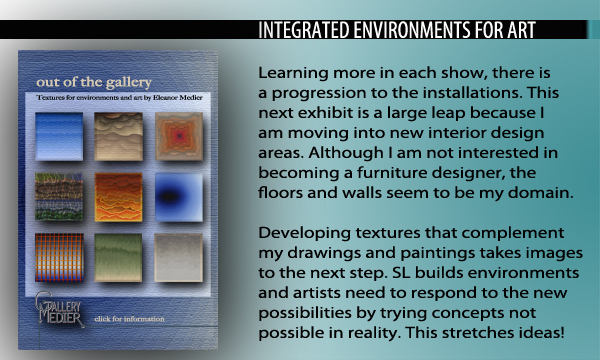It is impossible to have too many outlets for showing artwork. Having experience in gallery exhibits both as the artist showing and as the exhibit designer, expanding opportunities are irresistible! Virtual worlds are the new frontier of cultural growth. It is the ultimate melting pot of ideas and explorations. It is no short of profound.
Looking back on my year of showing virtually, I translate what I have learned in real life as an artist with these new frontiers:

• The Colors of Change—June 2011: Gallery Medier. I had my first virtual exhibit in a gallery designed for me. Comprised of only colored pencil drawings, the originals are book-sized and were debuted at the Noyes Cultural Center in Evanston near where I live. Taking these images into SL cracked the door of the potential in this new medium:
1. Scale becomes more dramatic. Images that are delicate in their originals can gain contrast and size, offering a new drama. Scale becomes a matter of personal preference and adapting to a site.
2. Gather fresh feedback. With viewers from all over the world, getting the reaction from other cultures is invaluable. What I discovered in this body of work—there is no consensus. Everyone seems to have a different favorite.
3. Openings sell art. Although it is wonderful to think that art can sell out of the virtual gallery without me being there, it rarely works it that way. Collectors like to interact. They like to know about the art and feel a personal connection. This happens through discussion and attention. I often meet guests at the gallery between shows and that sells art too. It is a one-on-one development.
4. Paintings and drawings become like prints. After digitization, the same image can be sold over and over. There are no originals. Having a background in printmaking, where there are numbered editions, is part of the perspective. But to sell a work with “no copy” is unlimited. The price has to be low so money is to be made in volume.
5. Do not show everything at once. Big shows are not good. It is too much to see. In real life, to have a show—and I have had a dozen—requires 20 to 30 works. That will never do inworld! First of all, viewers get lost with too much. Also, in the fast-paced environment, to get traffic back to the gallery, it has to change all the time. If one show contains a year’s worth of work—like this first drawing show—then it is like “spilling all your candy in the lobby.” It is much better to show half at a time, rotating.

• Thought Constructs—September 2011: Thothica Community’s Walkway Gallery. When showing at an art fair with Simulat Almendros, who creates portraits on the side while he directs the established and successful sim, he engaged me in conversation and offered me a show in his organization’s gallery. As one of SL’s cultural cornerstone, Thothica brings together philosophers, scientists, artists, and authors into a common forum. When he showed the gallery to me, I knew instantly what I wanted to do: create works from digital drawings I have not shown but have in my library. Created as Freehand book illustrations, the series parallels the drawing show I had done in the spring. That drawing show was taking real world drawings and importing them. This time, the art is totally created in the digital world—I expanded on my older concept to fit a new situation. Comprised of 12 images, the show to me had a magical quality. This time it could not exist in real life. Also I concluded:
6. Groups within SL are the way to promote. Thothica will not place announcements on the open SL Destination Guides because they can attract trouble makers. The sad reality of a created reality is that there are those who delight is causing inconvenience to other people. I have been a victim of such mischief so I can appreciate Thothica’s caution. Group promotion means relationship-building with the other members. Thothica has 1300 members, so to attract one that doesn’t know who I am takes work.
7. Openings are the perfect way to bring friends together. Similar to real life, the mix of friends is fascinating. But unlike real life, doing an opening in SL costs nothing. The show itself costs to download images and advertising can cost, but most promotion is a matter of hard work, not money. It takes time to attend other shows and make a strong circle of friends. It is in being willing to share that makes SL so rich.

• Flowers of Creativity—June 2012: Magnolia Center for the Arts. This was a step backwards in a way because I imported real life paintings similar to my first show where I had imported drawings. But it does display its own form of media integrity.
8. The gallery needs a host. Mary was able to sell many paintings while I was not around. A weakness of my own gallery is that I am not able to hang around and talk to people. If i were, I know I would sell a lot more artwork. But the translation of Lindens to dollars does not make this realistic. Money earned there is worth pennies on the dollar in real life. To think I could make a part-time living selling art virtually is not something I care to invest in. Instead, I use it as a visibility-raiser. Having help to do that is ideal.
9. Tie into other communities. Magnolia has a community that circles around its music venue where Mary has live concerts or DJs. Most of her efforts are placed here and the gallery is an additional attraction. However, Mary is learning about the arts community, is into promoting both venue, and I expanded my collectors through her audiences. I wish I had more time to go here music there. The concert that she hostessed for the opening really drew a crowd much to the delight of all present!

• Out of the Gallery—September 2012: Gallery Medier. As the next phase, I am about to open a new show. As a cross-over to my job as an editor/designer for Bowler Business Review, client Jetman Bowler hired a writer to interview me for the magazine at the time of the Magnolia show. This is certainly his right as the owner, but I don’t really feel an article on my gallery is of that much interest to business people, though I expanded the article to include issues about the gallery business and what I am currently doing. He seems to think so, and the article ran in BBR#2. I will have an event to launch the show in September, allowing me time to promote. The article does draw visitors which I can log and invite when the time comes. This show takes me back into using qualities in SL that I can’t use in RL:
10. Adapt to the space. Virtual reality is a medium. Often I use it like another piece of software for its 3d modeling or for photographs. I create my own environs there which takes the work out of the gallery. By developing the rooms where art is viewed, it becomes a more ambient experience.
11. Advertise. Imposing on friendships to have ads around in other sims builds recognition as it does in RL. It is impossible to have too many. Getting free ones versus paid ones is a challenge and can be time consuming. It feels better to earn money in easier ways and pay for kiosks in strategic places if the show changes a lot.
12. Think modularly. Rotating a show in a stable gallery is the best strategy for credibility. Then there is Marketplace to list complete lists. I have yet to learn how to promote this except to include a sort address on my publications within my other promotions. I have a lot to learn here but I have placed product collections there.
13. Design frequencies. I think a quarterly opening is the best schedule for events. Any more, and the event doesn’t seem special. Everyone has a lot of tugs on their time. So to rise high enough on their priority list that they come and buy art means it is a cool event not to be missed. My openings are very cool because they mix guests from the arts, business, communities, publications, and clubs. I had a lot of fun introducing the director of Book Island to the director of Thothica Community, for example. They each exclaimed with delight because they admire the other’s achievements. These kinds of interactions make my openings really fun for my friends.
Now begins my second year of virtually exhibiting. As a part-time pursuit, I get part-time results. If I had unlimited time to promote my artwork virtually, I do wonder at the potential. In the meantime, I am pleased the gallery makes enough money to pay for itself and my virtual overhead. It would be nice to have a flow of steady customers, but art sales is in spurts and fueled by continual efforts. I crawl along instead of run, but I learn what I am there to learn which applies to my world view.








Pingback: International Stage | Liane Sebastian